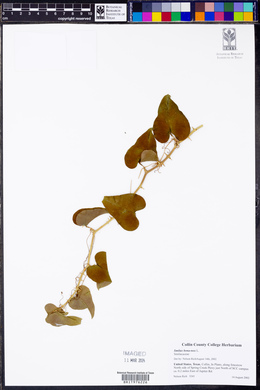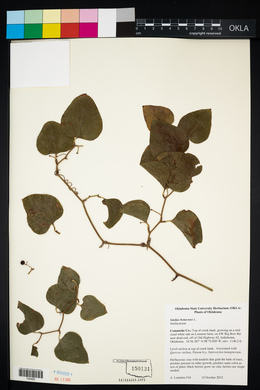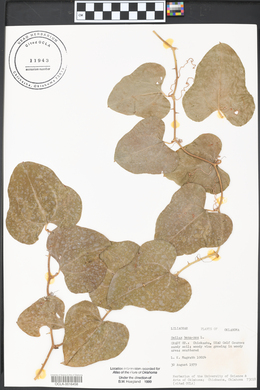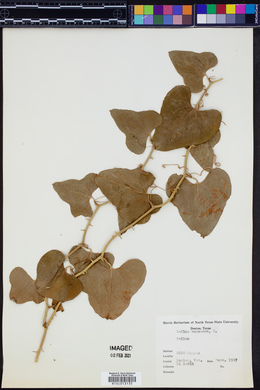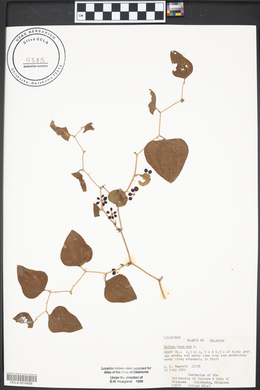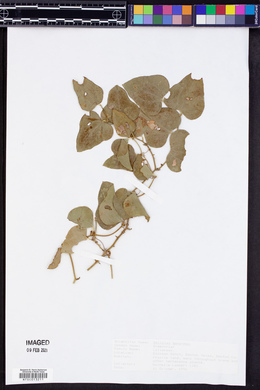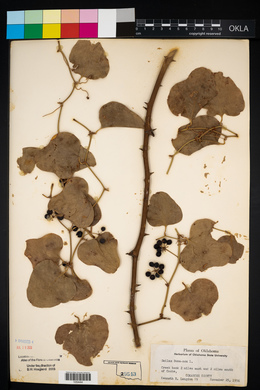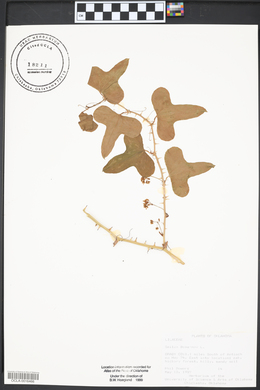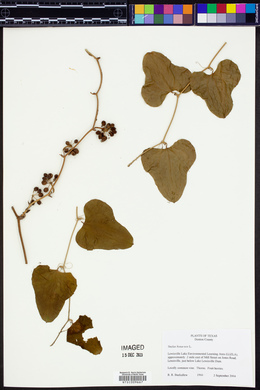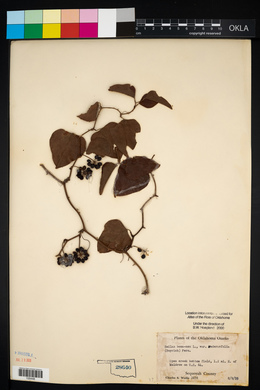Smilax bona-nox
|
|
|
|
Family: Smilacaceae
Fringed Greenbrier, more...saw greenbrier
[Smilax bona-nox var. littoralis Coker, moreSmilax medica] |
Vines; rhizomes tuberous, woody, or stoloniferous. Stems perennial, climbing, often zigzag distally, branched, terete to 4-angled, stout, to 5+ m × 5 mm, woody, glabrous or infrequently with stellate trichomes; prickles often absent distally, tips black, flattened, broad- based, stout, 4-9 mm, rigid. Leaves evergreen, ± evenly dispersed; petiole 0.7-1.5 cm; blade pale green, often with white blotches, drying to uniform tan, thickish, broadly ovate to lanceolate-ovate or hastate to pandurate, with 3(-5) ± prominent veins, 3-10 × 2.5-9 cm, not glaucous, glabrous or minutely pubescent abaxially, base cordate to truncate, frequently lobed; margins entire to remotely spinose-ciliate, thickened by ribbed, cartilaginous band, often revolute and appearing as prominent vein parallel to margins, apex rounded to short-apiculate. Umbels few to numerous, axillary to leaves, 10-15+-flowered, moderately dense; peduncle 1.5-6+ cm. Flowers: perianth pale green; tepals 3-4.5 mm; anthers shorter than to ± equaling filaments; ovule 1 per locule; pedicel 0.8-1.2 cm. Berries black, ovoid to spherical, 6-8 mm, shiny to dull, sometimes glaucous. 2n = 32. Flowering Apr--May. Well-drained to wet areas in woods, fields, thickets, hedgerows, floodplain forests, etc., full to partial sun; 0--1000 m; Ala., Ark., Del., D.C., Fla., Ga., Ill., Ind., Kans., Ky., La., Md., Miss., Mo., N.C., Ohio, Okla., S.C., Tenn., Tex., Va.; Mexico; West Indies. Numerous varieties, based mainly on differences in leaf shape, have been proposed for Smilax bona-nox. Variation is so great even in individual plants that recognition of these varieties is untenable. J. A. Steyermark (1963) suggested that leaf variation may be correlated with stages of plant maturity. The species often may be considered weedy, occurring in very dense, tangled masses.
Slender woody vine; stems usually 4-angled, diffusely branched and often climbing high, armed with large, stout, flattened prickles especially on the angles, or distally unarmed; lvs subcoriaceous and ±persistent, ovate to deltoid or hastate, 4-8 cm, green beneath, conspicuously thickened at the entire or spinulose margins; veinlets prominent; peduncles flattened, much longer than the subtending petiole; fr black, 6-8 mm, 1-seeded; 2n=32. Dry woods, thickets, abandoned fields, and roadsides; s. Md. to Mo. and se. Kans., s. to Fla. and Mex. May-July. Gleason, Henry A. & Cronquist, Arthur J. 1991. Manual of vascular plants of northeastern United States and adjacent Canada. lxxv + 910 pp. ©The New York Botanical Garden. All rights reserved. Used by permission. From Flora of Indiana (1940) by Charles C. Deam I have seen specimens from only the counties indicated on the map and I think Andrews' report from Monroe County can safely be transferred to the next species [Smilax rotundifolia]. So far it has been found only on the high hills near the Ohio River where it is usually associated with the next species [S. rotundifolia]. …… Indiana Coefficient of Conservatism: C = 5 Wetland Indicator Status: FACU Diagnostic Traits: woody at base; prickles rigid, green with black tips; tendrils present; lower leaf surface green, the margins thickened; peduncles >2 cm (>1.5× longer than petiole); fruits black, 1 seeded. |















